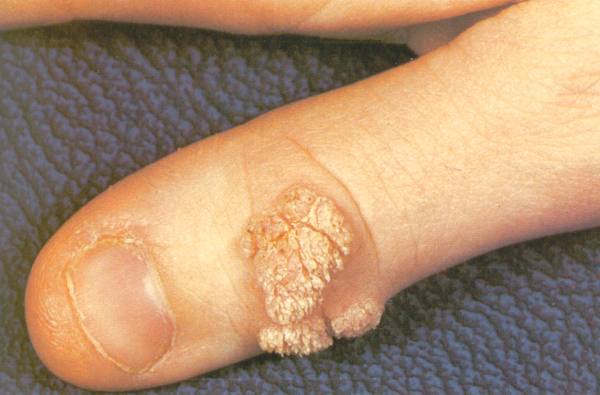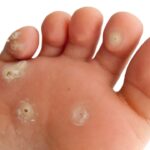Verruca vulgaris, commonly referred to as the common wart, is a benign skin lesion resulting from infection with the human papillomavirus (HPV), primarily types 2 and 4. These lesions are characterized by their rough, raised surface and commonly appear on the hands, fingers, knees, and other trauma-prone areas of the skin. Though non-cancerous, verruca vulgaris can be aesthetically undesirable and, in some cases, painful or irritating depending on location and size.

Causes and Transmission of Verruca Vulgaris
Role of Human Papillomavirus (HPV)
HPV infects the basal keratinocytes of the skin through microscopic breaks or abrasions. Once established, the virus induces hyperproliferation of epithelial cells, leading to wart formation.
Key Modes of Transmission:
- Direct skin-to-skin contact
- Indirect contact via contaminated surfaces (e.g., towels, tools)
- Autoinoculation from one site to another through scratching or shaving
Risk Factors:
- Damaged or broken skin
- Children and adolescents (due to developing immunity)
- Immunocompromised individuals
- Use of communal showers or gym equipment
Clinical Appearance and Symptoms
Typical Features of Verruca Vulgaris:
- Raised, flesh-colored or grayish lesions
- Rough, keratotic surface with dome shape
- Size ranges from a few millimeters to over a centimeter
- May appear singly or in clusters
These warts are often asymptomatic, but irritation or discomfort may occur when located on pressure points or due to frequent contact.
Common Locations of Verruca Vulgaris
| Location | Description |
|---|---|
| Hands & Fingers | Most frequent; periungual warts near nails common |
| Knees & Elbows | Often due to trauma or friction |
| Face | Usually in children; may spread via shaving |
| Lips & Oral Mucosa | Rare; requires clinical confirmation |
Pathogenesis of Verruca Vulgaris
Once inside the basal layer, the virus replicates and manipulates the cell cycle, bypassing immune detection and forming a hyperkeratotic papule.
Diagnostic Approach to Common Warts
Diagnosis of verruca vulgaris is largely clinical, though certain tools may enhance accuracy:
Diagnostic Criteria:
- Characteristic surface roughness
- Disruption of normal skin lines
- Presence of thrombosed capillaries (“black dots”)
- No associated pain unless pressure is applied
Additional Diagnostic Aids:
- Dermatoscopy: Reveals dotted vessels and interrupted dermatoglyphics
- Skin Biopsy: Rarely required but helpful for atypical lesions
- PCR Testing: Confirms HPV subtype if needed in research or complex cases
Differential Diagnosis
| Condition | Key Differentiator |
|---|---|
| Molluscum Contagiosum | Central umbilication, smoother surface |
| Seborrheic Keratosis | Greasy texture, stuck-on appearance |
| Actinic Keratosis | Sun-exposed areas, more erythematous |
| Squamous Cell Carcinoma | Rapid growth, ulceration, bleeding |
Complications Associated with Verruca Vulgaris
- Spread to adjacent skin (autoinoculation)
- Psychological distress due to visible lesions
- Secondary bacterial infection from scratching
- Potential resistance to standard treatment in immunocompromised individuals
Evidence-Based Treatment Options
1. Topical Therapy
- Salicylic Acid: First-line keratolytic agent; used daily over several weeks
- Tretinoin Cream: Often used in children for facial warts
- Imiquimod: Immune response modulator; enhances local antiviral activity
2. Cryotherapy
- Liquid nitrogen application leads to freezing and destruction of wart tissue
- May require 2–6 sessions spaced 1–2 weeks apart
- Side effects: blistering, pain, pigmentary changes
3. Electrosurgery and Curettage
- Used for larger, resistant lesions
- Effective but can result in scarring
4. Laser Therapy
- Pulsed Dye Laser: Targets blood vessels within the wart
- CO₂ Laser: Vaporizes wart with precision; useful in difficult-to-treat cases
5. Immunotherapy
- Intralesional injections: Candida antigen or MMR vaccine
- Activates systemic immune response to eradicate HPV
- Beneficial in multiple or recalcitrant warts
Natural History and Prognosis
- Spontaneous Resolution: Occurs in 50% of cases within two years
- Recurrence: Can occur if the virus persists in adjacent tissues
- Prognosis: Excellent with appropriate and persistent treatment
Home Remedies: Do They Work?
Though not clinically guaranteed, several home remedies are commonly used:
- Duct Tape Occlusion: Suffocates wart and peels off layers of infected skin
- Garlic Application: Believed to have antiviral properties
- Apple Cider Vinegar: Acidic nature mimics salicylic acid effect
These options may be viable for minor warts but should be approached with caution, especially in sensitive skin areas.
Preventive Measures
Key Prevention Strategies:
- Avoid touching or scratching warts
- Do not share personal grooming items
- Keep hands and feet dry and clean
- Use protective footwear in communal areas
- Boost immune health through nutrition and hygiene
Pediatric Considerations
- Warts are common among children due to underdeveloped immunity
- Painless methods like salicylic acid or duct tape are preferred
- Emphasis on minimizing trauma and educating about spread
Verruca Vulgaris vs Other Wart Types
| Type | Site | Distinguishing Feature |
|---|---|---|
| Verruca Plantaris | Soles of feet | Painful, inward growth under pressure |
| Filiform Warts | Face, eyelids | Finger-like projections |
| Flat Warts (Verruca Plana) | Face, arms | Smooth, flat-topped papules in lines |
| Genital Warts | Genital area | Soft, cauliflower-like appearance |
Frequently Asked Questions:
Is verruca vulgaris contagious?
Yes, it can spread through direct contact or contaminated surfaces.
How long do common warts last?
They may persist for months to years without treatment but often resolve spontaneously.
Can warts turn into cancer?
No, verruca vulgaris is benign. However, some HPV types associated with genital lesions can be oncogenic.
When should I see a dermatologist?
If the wart is painful, spreading, recurrent, or resistant to home treatments, consult a specialist.
Are warts more common in immunocompromised people?
Yes, these individuals may experience larger, more persistent lesions requiring advanced therapies.
Verruca vulgaris represents a common yet manageable dermatologic condition stemming from HPV infection. Through accurate diagnosis, appropriate treatment, and proactive prevention, these lesions can be effectively controlled and eradicated. As research advances, immunotherapeutic and vaccine-based approaches hold promise for broader management of recurrent or widespread wart infections.

